How Can Technology Help To Prevent Child Trafficking?
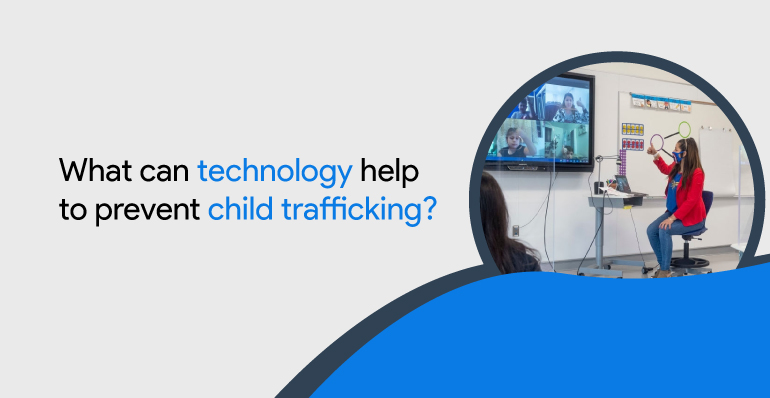
How Can Technology Help To Prevent Child Trafficking?
Technology can do so much more than the development of infrastructure. If used skillfully, we can use technology to solve many social problems. Among those many problems, technology is and can help to prevent child trafficking.
We can use AI-based technology like Virtual Reality to simulate a situation similar to child trafficking to make people aware of it. Likewise, we can use various parental monitoring apps to monitor and track children’s whereabouts and their online activities so that you can take precautions before the situation takes place.
Like the above examples, technology can prevent child trafficking in so many other ways. Here I have broadly categorized how technology can help to prevent child trafficking in six different terms.
Monitoring Technology
The first thing you can do to protect your children from child trafficking is monitoring your child. There is a parental control and monitoring software out there that you can use to track and monitor your kids. This software can help you track all activities like browser history, GPS location, call history, text messages, photos, videos, and screenshots.
You can also use monitoring apps to track your kid’s social media like WhatsApp, Snapchat, Facebook, Instagram, and more. You can use monitoring apps to know where your child is, what your child is doing, who your child is interacting with, etc. Thus, it helps to protect your child.
How Can Monitoring Apps Prevent Child Trafficking?
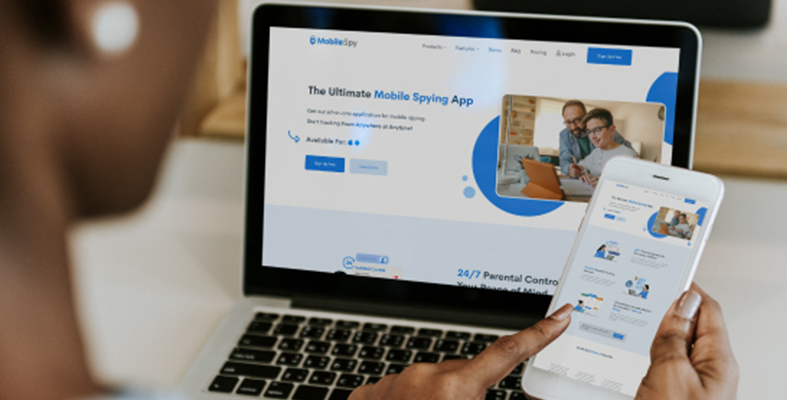
Monitoring apps consist of various features that help know what your children are up to and their whereabouts. The features include:
Call Tracker
Monitoring apps let you track all the calls made and received by your child remotely. For instance, you can know if your child is talking to an unknown person. You can also listen to call recordings that help you to understand what they are talking about secretly. In this way, you can quickly determine if the person your child’s talking to is a trafficker.
Social Media Monitoring
You can use monitoring apps to monitor your child’s social media accounts like Instagram, Snapchat, Facebook, Viber, etc. Moreover, it helps you know your children’s friends on social media, who your children are talking to, what they are talking about secretly.
GPS Location Tracking
Tracking phone GPS location will help you to get information on your child’s location in real-time. It helps to know where your children are. Moreover, you can also set up a virtual boundary around a specific geographic area. That means you can restrict your kids from going into certain places. Therefore, if they enter into such sites, you get an alert.
SMS Tracker
SMS Tracker feature tracks all the incoming and outgoing messages on your child’s phone. So, following your child’s exchanged messages with others will provide you with a clear idea of the contents exchanged, the types of conversation, and the amount of time your child is spending on texting.
For instance, there might be the possibility of your child responding to the traffickers prevalent on the internet and can prevent it with the SMS tracker feature.
Other Features
You can also use monitoring apps to monitor multimedia so that you can view the photos and videos exchanged by your kids. You can also access their emails and track their internet history.
Best Monitoring Apps
Some of the best parental control apps that helps you to prevent child trafficking are:
- Bark
- FlexiSPY
- FamilyTime
- MobileSpy
- mSpy
- Qustodio
- Norton
- Screentime
Facial Recognition Technology
The facial recognition technology uses AI to scan the internet for child sexual abuse material(CSAM) at a very high speed. For instance, Facial recognition automatically identifies victims of trafficking and saves law enforcement time.
Project VIC and Two Hat Security have developed software that uses facial recognition and video fingerprinting to recognize children and illicit content to monitor and delete CSAM from the internet. Anyone will participate in the fight against child trafficking by using user-generated datasets.
The various image recognition technology that helps to prevent child trafficking are:
Spotlight
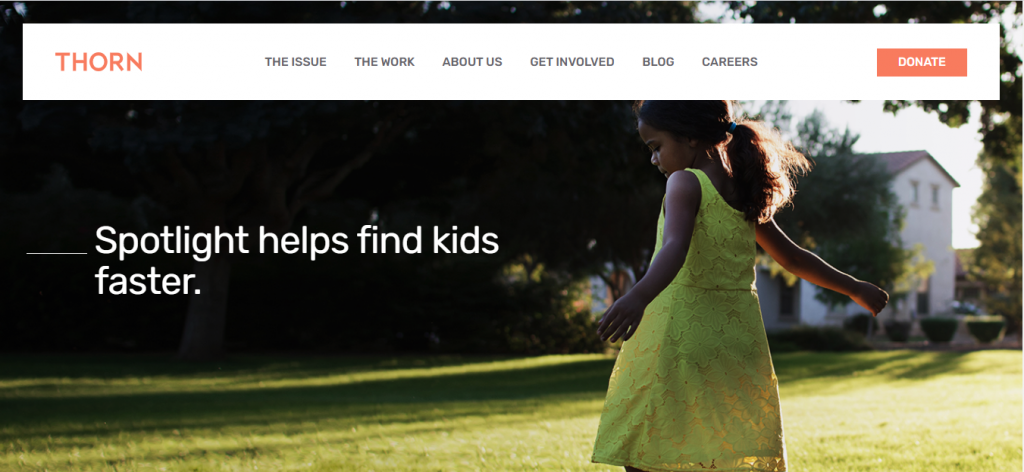
Thorn used Spotlight to fight against human trafficking. Spotlight transforms this vast volume of data into a helpful tool for law enforcement. Spotlight’s mission is to enhance the efficacy and quality of domestic sex trafficking prosecutions and maximize the number of children who are detected and linked to support services.
Its features are:
- It gathers insights from millions of data points to identify and locate those at risk.
- It also helps to reallocate time spent on investigating to recovering victims.
- Moreover, Spotlight reduces the risk of following misleading information.
- To fit with the investigation process, focus on basic functionality built with direct law enforcement input.
Traffic Jam
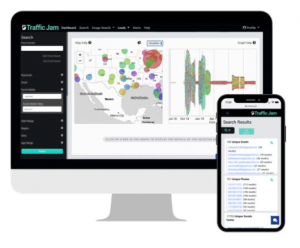 Traffic Jam by Marinus Analytics can search the internet and connect images of lost children in sex ads with trafficking victims. For instance, it develops victim-centered, trauma-informed policy strategies, emphasizing the more severe aspects of exploitation and information to direct attention to the most extreme sex trafficking risks.
Traffic Jam by Marinus Analytics can search the internet and connect images of lost children in sex ads with trafficking victims. For instance, it develops victim-centered, trauma-informed policy strategies, emphasizing the more severe aspects of exploitation and information to direct attention to the most extreme sex trafficking risks.
Furthermore, Traffic Jam helps law enforcement do three essential things. They are: stop human trafficking, fight organized crime, and find missing persons.
TraffickCam
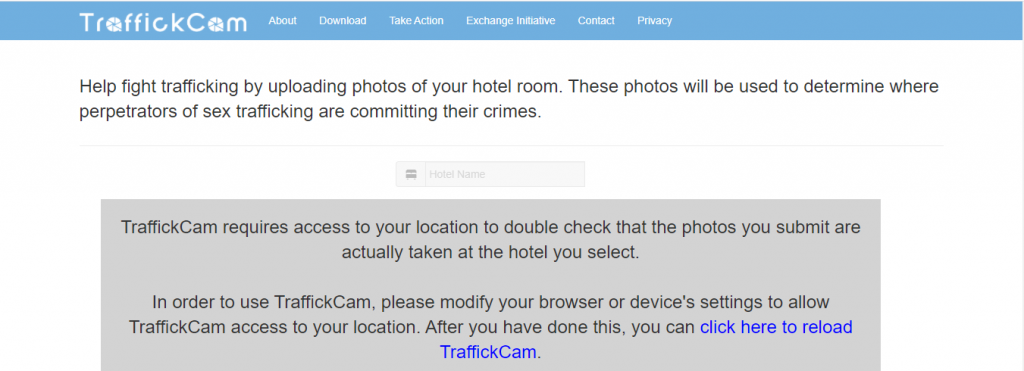
TraffickCam is a software that uses public photographs of hotel rooms to assist law enforcement in matching images of their venue.
For internet advertising, dealers often upload photos of their victims standing in hotel rooms. These photos are evidence that we can use to track down and punish the suspects. However, to use these images, prosecutors must be able to pinpoint their whereabouts.
Moreover, TraffickCam aims to develop a database of hotel room photographs so an investigator can scan to locate more photos captured in the same place as an image they are investigating.
Awareness Technology
Here awareness technology refers to technology like apps, games, websites, and virtual reality (VR) that raise awareness about human trafficking to the general public. Awareness technology can also help prevent child trafficking.
Operation Red Alert has teamed up with Oculus VR for Good and filmmaker Jayisha Patel to create a robust virtual reality film that immerses audiences in the stories of human trafficking victims
Likewise, BAN Sex Trafficking, (Un)Trafficked, and The Lifeboat Project have developed choose-your-own-adventure game applications that enable players to play through simulations to discover the signs of human trafficking and receive support and updates on legal options.
Read More: Technology Can Increase Your Child’s Social Awareness?
Reporting Technology
Many organizations are focused on developing a reporting technology to report suspicious activity or known trafficking and provide witnesses to trafficking situations. Some of the apps developed for reporting in such trafficking cases are:
The STOP APP
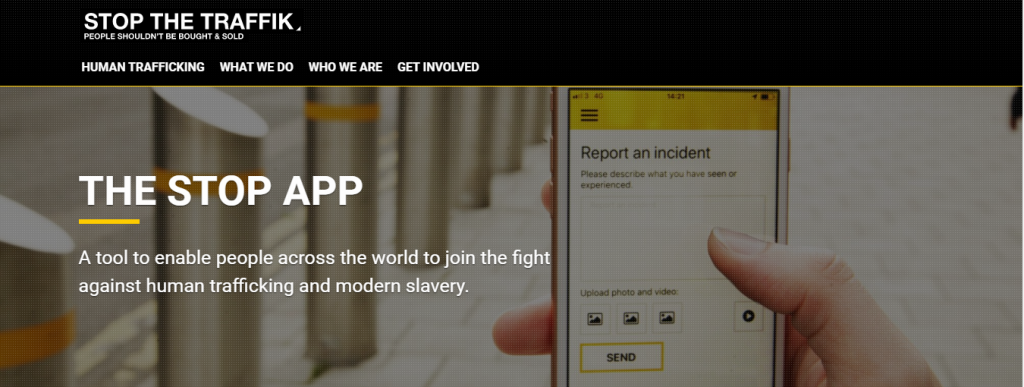
Anyone with a smartphone can download the STOP APP from any location in the world. The app is confidential, anonymous, and secure. It comes in seven different languages and helps you report suspicious activities quickly by sending text messages and sharing images and videos.
Furthermore, all information submitted into the STOP APP is sent directly to the protected archive of STOP THE TRAFFIK. STOP APP analyses this information alongside various databases on sex trafficking and modern slavery operation.
CyberTipline
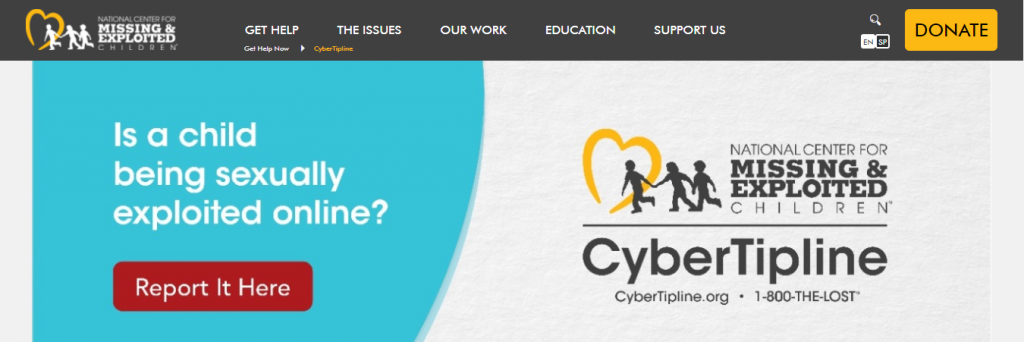
CyberTipline helps to prevent the online exploitation of children. For instance, the electronic and public service providers can make reports of suspected child sex tourism, child sex trafficking, extra-familial child sexual molestation, online enticement of children for sexual acts, misleading domain names, child pornography, unsolicited obscene materials sent to a child, and misleading words or digital pictures on the internet.
Database Management Technology
Global data hubs operate as networks for gathering data on human slavery, both from consumers and machines worldwide. The Child Labour Tracking System in India maintains track of previously unrecorded data or contradictory across ministries. It now supports tracking human trafficking, wages, vulnerable areas, employers, and more and registering saved children.
The United Nations Migration Agency’s Counter-Trafficking Data Collaborative is also the most comprehensive database. This database receives submissions from over 200 countries. For instance, it analyzes the most common types of trafficking by country, age, and gender of victims and how the traffickers control victims using geographic-specific information on over 90,000 incidents.
Deep Learning and Artificial Intelligence (AI)
A broad range of programs, channels, and organizations delve further into the technology that can help combat child trafficking. Organizations like Seattle Against Slavery and Hyperion Gray are mapping and clustering dark web pages to shine a light on obscure regions of the internet and targeting, deterring, delaying, and gathering data on potential customers.
How do AI and Deep Learning prevent child trafficking?
Deep Learning and AI technology can help prevent child trafficking in so many ways. Many organizations have developed AI bots and algorithms that help to get information and find child traffickers using AI technologies.
- Terre Des Hommes created a simulated 10-year-old girl to bait, trap, and unmask prospective customers and criminals while gathering evidence to enforce the latest legislation in response to the child sex tourism industry through a webcam.
- Rebecca Portnoff, a doctoral student at the University of California-Berkeley, designed two algorithms to track traffickers and victims. By detecting non-consensual sex advertisements, linking related writing styles through various ads, and uncovering bitcoin transactions.
- Moreover, people have designed many AI tools to inspire other everyday people who want to combat sex abuse in their neighborhoods.
Some of the most notable technological advances increasing the work of those combating slavery contain:
The DARPA’s (Defense Advanced Research Projects Agency) Memex program was launched in 2014 with the aim of combatting human trafficking with the help of an advanced search engine. DARPA has promoted the research, which mainly concentrates on revolutionizing technology in the anti-trafficking space. But this tool is not available widely.
Microsoft’s Photo DNA helps to identify all the cases related to child abduction, exploitation, and abuse. The main intention behind Photo DNA is to identify the issues and recover from them. It is available for all those qualified organizations whose objective is to fight against child exploitation. Microsoft has provided Photo DNA for gratis to law enforcement through the forensic tool developers. The main focus is to protect the children.
Thorn and Polaris collaborate with Twilio and Salesforce Foundation to create the National Human Trafficking Resource Center (NHTRC) SMS-based textline; sufferers can text the shortcode “BE FREE” to access the hotline, which is a careful and time-efficient way.
My Final Thoughts
Therefore, by using various technologies based on monitoring, facial recognition, awareness, reporting, database, and AI, we can not only prevent child trafficking but also find the traffickers and stop them.
Therefore, the general public and law enforcement should be made aware of these technologies. More than that, people should be encouraged to use such apps and tools to prevent and stop a child or any other kind of trafficking.



 WhatsApp Spy
WhatsApp Spy Facebook & Messenger Spy
Facebook & Messenger Spy Viber Spy
Viber Spy Instagram Spy
Instagram Spy Skype Spy
Skype Spy TikTok Spy
TikTok Spy Telegram Spy
Telegram Spy LinkedIn Spy
LinkedIn Spy Twitter Spy
Twitter Spy Youtube Spy
Youtube Spy Photo Spy
Photo Spy Video Spy
Video Spy Calls and Contacts Tracking
Calls and Contacts Tracking SMS & IM Chats
SMS & IM Chats Voice Capture
Voice Capture Image Capture
Image Capture Video Record
Video Record